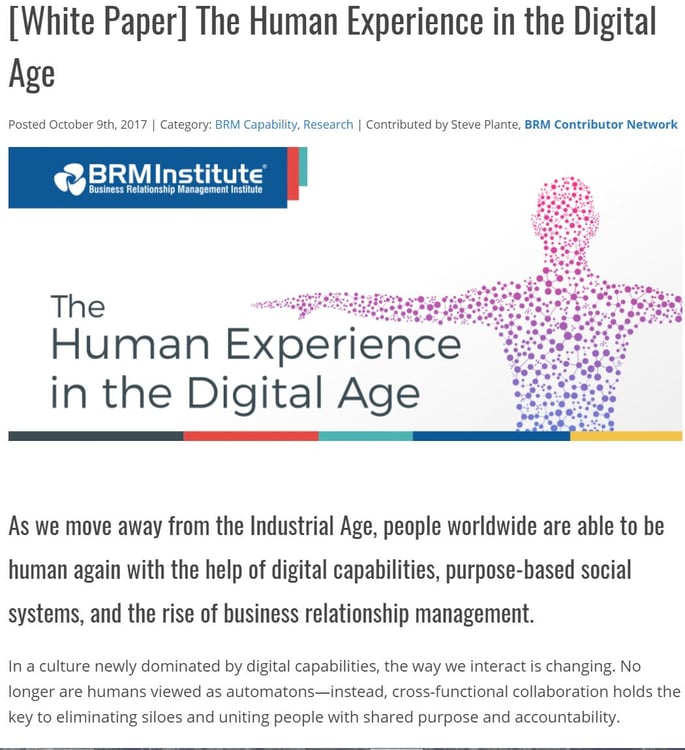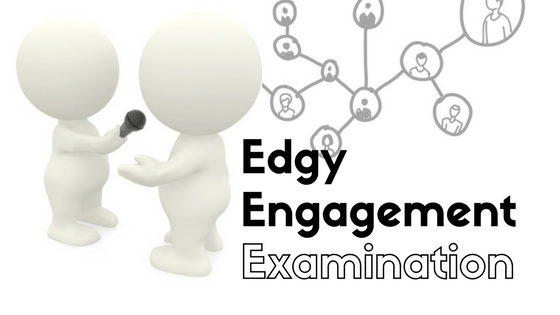
Check out PeopleProductive's Steve Plante's, Chief Strategist & Education Officer, powerful article, The Human Experience in the Digital Age, published by Business Relationship Management Institute.
Read the full article: https://brm.institute/white-paper-human-experience-digital-age/
_____________________________________________________________________________________________________________
Cynical Questions from Steve Stanton
Sincere Answers from Frank Wander
Q. In today’s era of rampant automation, why should a smart CEO care about employee engagement? Many of these folks may soon be gone. Shouldn’t CEOs be planning for robotic engagement?
The way engagement works today, I don't think they should care about engagement! The engagement industry has been a failure. I don’t know of any company that became great because they used an annual engagement assessment and then told their managers to look at the results and make things better. Engagement arms HR with some data and insights, but it doesn’t help the business folks who have to get the work done. It never has. At the end of the day, traditional engagement assessment cannot create better business outcomes. How could they? CEO’s should care about growing their businesses by creating value for their customers. To accomplish that, having a highly skilled, motivated, inspired and empowered workforce is vital. That’s not engagement. It’s a leadership team that has the skills to do that.
Beyond that, you ask about robotic engagement. Recently, the CEO of Deloitte, North America, Cathy Englebert, spoke about diversity in the workplace and brought up the topic of learning to embrace your robot co-workers - Co-bots. It is an emerging topic, but I don’t agree with the using the word embrace. That isn’t going to happen. But accepting the bots because they eliminate repetitive tasks, and leave more complex, more interesting work for people, is a good thing. There is no stopping this trend. It’s progress.
Q. What does engagement really look like? How would you know it if you saw it?
I would say the reality of engagement can be seen in what it feels like, not what it looks like. Some leaders can sense the workplace, feel the energy and vibe and quickly read the organizational pulse. Personally, I can immediately feel what shape a workplace is in. Having done turnaround transformations across many companies, the fear, low energy, and protective behaviors found in broken organizations are immediately palpable. I could sense it the minute I entered the place. However, as the turnaround progressed, and workers realized I cared about them and their success, the buzz would radically change. The vibe, energy, mood and pace one feels from a group of highly motivated and committed workers is easy to feel if you have that skill. Some people are blind to others feelings. They won’t “see it”
Q. Why is improving employee engagement so difficult for large organizations?
That’s a blanket statement that is just not true. Some large organizations are very good at creating amazing cultures - just look at WL Gore, Southwest Airlines, Costco, SAS, and Google, to name a few. These best places to work all have leaders that care about their people as human beings. SAS has perennially been at the top of the best places to work, and it is all about their founder and CEO, Jim Goodnight, who realized that satisfied employees were at the root of successful business. He is noted for saying that every night his assets drive out of the parking lot, and it is his job to make sure they come back. They have had one of the lowest employee turnover rates in the tech industry on-going, and have a brilliant track record of innovation and growth.
So, it comes down to having leaders with the elusive “get it” factor for the people side of business. Unfortunately, the actual root emotional causes of engagement/disengagement remain a blind spot across a large part of corporate America. Leaders know everything about their financials, business systems, competitors, strategy, plans, processes, and regulations, and almost nothing about what makes people tick. Getting the human side of business optimized and running well just hasn’t been a focus in traditional corporate America. It has unfortunately been about short-term results.
Companies can rectify this if they are willing to get rid of the toxic leaders and build a workplace that people want to come to, and then stay. This is a leadership issue. Many could become highly productive, very good places to work. They just have to make learning how to do this a priority. It is not a campaign or slogan, it is a way of leading.
Q. Can you quantify the benefits of engagement?
Engagement is just a measure, not a business outcome. I think CEO’s should actually care about how culture and productivity can be used to achieve the outcomes they desire. Creating fluid cross-functional collaboration at every level of the organization is very powerful and that is what is needed today. In this regard, CEO’s and the executive leadership team must lead by example and work together to shape company culture. They need to use the human factors of productivity to improve collaboration, innovation and program delivery. Ultimately it is about winning.
Since it is not about engagement, but a tuned-in leadership team, we can quantify the productivity impact of leaders who create great places to work. For instance, Apple, Google, Dell and Netflix are 40% more productive than their peers according to research by Bain Consulting. One would think this is due to the quality of the talent they attract. However, that is not the case. The former have 16% star performers, versus 15% at their less productive competitors. So, it is not talent, it is the fact they have eliminated organizational drag by eliminating unproductive processes and built a work environment that is supportive of problem solving and thinking. They also inspire employees and focus on collective outcomes, not individuals. Clearly, leaders who get it, and know how to get the best out of their people, lead the top performing companies. Throw your engagement assessments away. They’ll never make your organization great.
Q. How do you connect customer impact with employee engagement?
It is a fact that the customer experience is an emotional one. The emotions of the employees, and how they tie directly to the customer experience are well documented. Take Wal-Mart and Costco. Costco has workers who feel management values them and cares about them. That caring vibe carries directly over into the customer experience. Consequently, Costco produces more revenue per square foot, and has higher customer loyalty. There are just so many examples where this is empirically true.
One can compare Southwest and United airlines if you want to see how having employees that care makes the brand. In the case of United, everyone will remember the image of the bloodied passenger being forcefully removed from the plane even though they had a ticket and were already seated. Compare that to the Southwest employee driving lost luggage to a passenger’s home at 3:00 AM because they needed their cancer medicine. That employee did it totally of their own volition. The passenger was so moved, they called the news. That is a great culture, and an employee who cares. Once again, it is not about engagement but getting the people side of the company working right.
Q. Is engagement a project, campaign, a slogan, or a cultural artifact?
When engagement is a project, it fails; when it is a campaign, it fails. When it is a byproduct of healthy culture, it is real. There are only two choices: It must be real, or it’s fake. If it is real, it is because of talented leadership.
Q. What are the most popular ways to fail at engaging employees?
Engagement almost always fails. Improvements are marginal. If you look at Gallup’s deep and extensive engagement analytics, the engagement needle has barely moved in the last decade.
So, if a company wants to fail at engaging employees, do an annual engagement assessment, pass out results four months later, tell your leaders to fix it, and then take a checkpoint and see if anything changed next year. This methodology could never work, and it hasn’t. Giving managers four-month old data is like trying to manage your investments using four-month old financial information. This annual investment has been a total waste of money, yet it still goes on, and HR leaders fight to keep it in their budgets.
Another common failure is talking up the importance of engagement, but not meaning it. That is not only a great way to fail, it is actually more harmful than doing nothing.
Similarly, many companies have wonderful values, like People Matter. However, they are nothing more than good signage. I saw that at a number of places I worked. The senior executives spent a lot of time hashing these values out, but had no idea how to live them. They were merely slogans, not a way of doing business.
Q. In terms of enhancing engagement, what should process designers think about when redesigning a process?
Process discipline is fundamental to building a high performing workplace that is both engaged and enabled. I was always a big advocate of process optimization, process ownership and putting a sensible governance model in place so workers understood “how work gets done here”. Absent this collective understanding, work becomes one barrier after another. That is incredibly frustrating. If you want to disengage motivated workers, put them in a chaotic mess where everyone gropes around to find our how to accomplish their work. Enablement is as important as engagement. You need both. Here, process is the key.
Beyond process, you can empower your employees by delegating outcomes and shunning micro-management; you can understand what drives them and help them fulfill their achievement needs; and, you help them grow by matching training with assignments so they can immediately apply that training on the job. If you also build an inclusive culture where team members have a deep sense of belonging, you are on your way.
Q. What are the big demographic issues that can either limit or enhance engagement?
Demographics have always been part of the workplace with three, even four, generations working together. Many people decry the Millennials, yet the baby boomers were decried in their day as the self-serving, drugged out, unreliable “me” generation. The truth is the boomer generation had many good, average and below average people, as is the norm. Knowing this, I find accepting the differences between generations becomes very powerful because the young folks entering the workforce have different attitudes, drives and experiences. Tapping these is the key. A good example today is reverse mentoring, where Millennials educate older workers on modern, social technologies.
I think the hard working Millennials need to be embraced by corporations, and accepted for who they are. They are digital natives and have a lot to offer in terms of using technology and collaborating to get things done.
Lastly, I would say the workforce is also changing in terms of Gig workers. It remains to be seen if this becomes different than the consulting that has been prevalent for years, but whatever shape it does take, these folks need to be embraced. A culture that is open and accepting stands a much better chance of successfully integrating workers like these.
Q. At your Company, People Productive, which stakeholders come first?
On this one, I have to agree with Richard Branson, best known for Virgin Airlines and all the other businesses under that brand. Their company value is that employees come first, customers second and shareholders third. In line with that is this quote: “If you want to win in the marketplace, you must first win in the workplace” (Doug Conant, turnaround CEO of Cambell’s Soup).
Today, more than ever before, we find more and more leaders with that elusive “get it” factor when it comes to people. I predict, that as time goes by, people will look back on this passing era of humans as parts and wonder how companies could have ever been so uninformed about their human capital investments.
About Steve Stanton
Steve is the author of the recently published book, “Smart Work: Why Organizations Full of Intelligent People Do So Many Dumb Things and What You Can Do About It.” He is a pioneer of process innovation. For thirty years his work has been focused on improving the capability of organizations to transform themselves. Mr. Stanton is also the co-author, with Dr. Hammer, of “The Reengineering Revolution” (HarperBusiness) and the Harvard Business Review article “How Process Organizations Really Work.” Mr. Stanton holds an MBA from Harvard and a BA from the Berklee School of Music.
About Frank Wander
Frank Wander, a former turnaround CIO, is founder and CEO of PeopleProductive (peopleproductive.com), a workforce productivity company that helps customers get the best out of their people. PeopleProductive is Talent Management Reimagined®. He is also the author of Transforming IT Culture: How to Use Social Intelligence, Human Factors and Collaboration to Create an IT Department That Outperforms (Wiley Publishing). This unique book is the very first operator’s manual for the human infrastructure, and will help you successfully transform your leadership style and your organization.
From the team at PeopleProductive
We're thrilled to have your interest in our work and we invite you to join our mission of creating work places where the people as well as the company, both flourish. We welcome your support and participation. To find out more about this just reach out to us here!"


